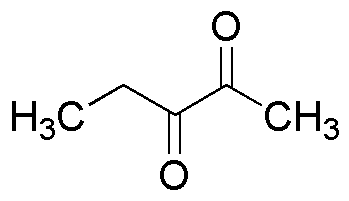2,3-Pentanedione is widely utilized in research focused on:
- Flavoring and Fragrance Industry: This compound is often used as a flavoring agent in food products and as a fragrance in cosmetics, providing a buttery or creamy note that enhances sensory appeal.
- Pharmaceutical Development: It serves as an important intermediate in the synthesis of various pharmaceuticals, contributing to the development of drugs with enhanced efficacy and reduced side effects.
- Analytical Chemistry: 2,3-Pentanedione is employed in analytical techniques, particularly in the detection and quantification of metal ions through chelation, making it valuable in environmental monitoring.
- Polymer Production: This compound is used in the production of polymers and resins, improving material properties such as flexibility and durability, which are essential in manufacturing processes.
- Research in Organic Synthesis: It acts as a versatile building block in organic synthesis, allowing chemists to create complex molecules efficiently, thereby accelerating research and development in various chemical fields.
General Information
Properties
Safety and Regulations
Applications
2,3-Pentanedione is widely utilized in research focused on:
- Flavoring and Fragrance Industry: This compound is often used as a flavoring agent in food products and as a fragrance in cosmetics, providing a buttery or creamy note that enhances sensory appeal.
- Pharmaceutical Development: It serves as an important intermediate in the synthesis of various pharmaceuticals, contributing to the development of drugs with enhanced efficacy and reduced side effects.
- Analytical Chemistry: 2,3-Pentanedione is employed in analytical techniques, particularly in the detection and quantification of metal ions through chelation, making it valuable in environmental monitoring.
- Polymer Production: This compound is used in the production of polymers and resins, improving material properties such as flexibility and durability, which are essential in manufacturing processes.
- Research in Organic Synthesis: It acts as a versatile building block in organic synthesis, allowing chemists to create complex molecules efficiently, thereby accelerating research and development in various chemical fields.
Documents
Safety Data Sheets (SDS)
The SDS provides comprehensive safety information on handling, storage, and disposal of the product.
Product Specification (PS)
The PS provides a comprehensive breakdown of the product’s properties, including chemical composition, physical state, purity, and storage requirements. It also details acceptable quality ranges and the product's intended applications.
Certificates of Analysis (COA)
Search for Certificates of Analysis (COA) by entering the products Lot Number. Lot and Batch Numbers can be found on a product’s label following the words ‘Lot’ or ‘Batch’.
*Catalog Number
*Lot Number
Certificates Of Origin (COO)
This COO confirms the country where the product was manufactured, and also details the materials and components used in it and whether it is derived from natural, synthetic, or other specific sources. This certificate may be required for customs, trade, and regulatory compliance.
*Catalog Number
*Lot Number
Safety Data Sheets (SDS)
The SDS provides comprehensive safety information on handling, storage, and disposal of the product.
DownloadProduct Specification (PS)
The PS provides a comprehensive breakdown of the product’s properties, including chemical composition, physical state, purity, and storage requirements. It also details acceptable quality ranges and the product's intended applications.
DownloadCertificates of Analysis (COA)
Search for Certificates of Analysis (COA) by entering the products Lot Number. Lot and Batch Numbers can be found on a product’s label following the words ‘Lot’ or ‘Batch’.
*Catalog Number
*Lot Number
Certificates Of Origin (COO)
This COO confirms the country where the product was manufactured, and also details the materials and components used in it and whether it is derived from natural, synthetic, or other specific sources. This certificate may be required for customs, trade, and regulatory compliance.


